Opinion & Analysis
The data behind Luke Donald’s decision to change instructors
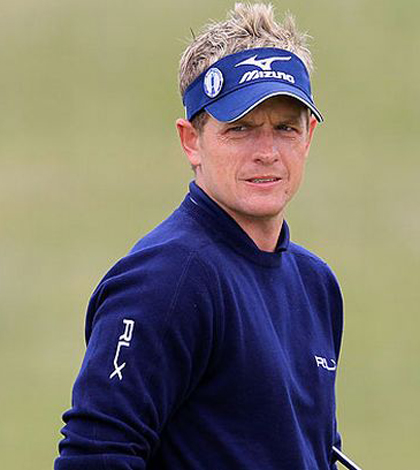
Luke Donald recently made an instructor change to Texas-based swing coach Chuck Cook.
Back in 2011, Donald had an epic season. He finished first on the PGA Tour money list and the European Tour’s Order of Merit. He also became the No. 1-ranked golfer in the world. So the next obvious step for Donald was to win a major championship. But the fine play he exhibited in 2011 rarely resurfaced in 2012. He regained some of his old magic in 2013, but not enough to leave him satisfied.
So, what has happened to Donald’s game to make him switch instructors? First, let’s take a look at some basic scoring analysis, comparing his 2011 season versus his 2013 season.
The order of importance of these metrics when it comes to mathematically correlating to success on Tour is as follows:
- Par-4 Scoring Average
- Bogey Rate
- Par-5 Scoring Average
- Birdie Rate
- Par-3 Scoring Average
So, the major drop-offs were in metrics Nos. 2, 3 and 4.
Bogey Rate is the most important metric here. Having a low Bogey Rate is about two aspects of the game:
- Being able to save par.
- Being able to hit your approach shots close to the hole, where it greatly decreases the odds of making bogey.
The latter is what many golfers do not understand about why Bogey Rate is more important (from a mathematical standpoint) than Birdie Rate. The best way to avoid bogeys is to not put yourself in position to make them. Even the worst putters in the world are not going to make bogeys if they hit 16 or more greens per round and have an average birdie putt of less than 20 feet.
With that said, let’s take a look at Donald’s key performance metrics of 2011 versus 2013:
First, we should acknowledge that Luke’s 2011 season could very well never be replicated again. He ranked No. 1 on shots from 75 to 125 yards and shots from 125 to 175 yards. He also ranked first in Putts Gained. It is no small wonder why he played so brilliantly in 2011; if he had an approach shot from 175 yards or less he was by far the best player in the world. And if he was farther than 175 yards away from the hole, he was very good.
With that said, we start to see a noticeable difference in his play on the longer approach shots. When we examine it more closely we start to see a fairly large regression. Here are Donald’s rankings on long approach shots from the fairway/tee box in 2011 versus 2012.
This would explain the increase in Bogey Rate. Longer approach shots, particularly those from the Danger Zone, is where golfers tend to put themselves in position to make a bogey or a double bogey. Donald has seen a fairly large drop off on shots from 150 to 175 yards, but a massive drop off on shots from 200 to 225 yards.
Donald has never been very effective off the tee since he has been on Tour. In fact, his 2011 season (where he finished 132nd in Driving Effectiveness) was his best year with the driver on Tour. I believe that is what has held him back from winning a major, and why a course like Augusta National ends up fitting him the best out of all of the majors championship venues. It is very much an approach-shot-oriented course, and one where putting is extremely important. The other majors often require more precise and effective driving of the ball. The drawback is that Augusta also favors long hitters, which hurts Donald’s odds of winning a major there.
I would imagine that part of the change to a new instructor was that Donald hoped he could improve his tee play. At his club-head speed and distance off the tee, he needs to be able to hit about at least 68 percent of his fairways and get his Average Distance to the Edge of the Fairway to around 22 feet or less. Here is Donald’s data in these metrics during the past four years:
While Donald is not very far away from hitting 68 percent plus of his fairways and having an average Distance to the Edge of the Fairway of 22 feet or less, it goes to show that the slightest discrepancy can be the difference between being forecasted to win a major or two and having yet to win a major.
What I find interesting about Donald’s driving is in the radar data. Last year, there was a launch monitor report circulating on the web of Donald’s impact data. The launch monitor had Donald with a 2.5-degree downward attack angle with the driver. However, if you look at his radar metrics for this year on Tour there are some things that do not quite add up.
What we know about downward attack angles with the driver is that they result in golfers not hitting the ball as high or as far as they normally would with a “flat” attack angle or an upward attack angle. Furthermore, the downward attack angle will produce a higher spin rate.
What we see is that Donald’s distance ranking is noticeably worse than his ranking in clubhead speed. That is part of what we would logically assume given his downward attack angle. Furthermore, he has the 19th highest Spin Rate on Tour (2,922 RPMs). This is also in line with a golfer that hits the ball with a downward attack angle with the driver.
However, there are some contradictory metrics. His launch angle is fairly high (11.25 degrees), and he has the 41st highest ball flight on Tour. And as we know, higher clubhead speed players will generally hit the ball higher as well. Donald is a lower clubhead speed player who has a high ball flight. He is also doing it with a fairly high launch angle, but the spin rate is high.
I think the key piece to this is his ranking in Smash Factor (91st). And I believe what is happening for Donald is that he is hitting above the “sweet spot” on his driver. Tom Wishon has discussed how hitting above the “sweet spot” affects the ball’s flight with this diagram.
Drivers are not designed to have a perfectly flat face. They have something called “vertical face roll,” which means that the face of the driver has a bulging design and the bulge runs horizontally (face bulged) and vertically (face roll).
With the larger 460cc drivers, this produces a club where if the golfer hits below the “sweet spot,” there is less loft. Conversely, if the golfer hits above the sweet spot, there is more loft. From there, the horizontal gear effect comes into play and if the golfer hits the ball above the sweet spot, that means the gear effect will reduce the spin on the ball.
Here are Donald’s radar metrics during the past four years.
Perhaps changes in equipment are a reason behind Donald’s unorthodox radar numbers given his 2.5-degree downward attack angle. But, his spin rate has lowered while his trajectory has gotten higher. And he still has an issue with getting his distance off the tee to match his club-head speed.
Donald will have his work cut out for him. But if he can get his long approach shot play back to his 2011 performance he will be very close to his old form. And if he can figure out his driving woes on top of it, he can be even better than he once was.
- LIKE0
- LEGIT0
- WOW1
- LOL0
- IDHT0
- FLOP0
- OB0
- SHANK0
Opinion & Analysis
The Wedge Guy: What really makes a wedge work? Part 1

Of all the clubs in our bags, wedges are almost always the simplest in construction and, therefore, the easiest to analyze what might make one work differently from another if you know what to look for.
Wedges are a lot less mysterious than drivers, of course, as the major brands are working with a lot of “pixie dust” inside these modern marvels. That’s carrying over more to irons now, with so many new models featuring internal multi-material technologies, and almost all of them having a “badge” or insert in the back to allow more complex graphics while hiding the actual distribution of mass.
But when it comes to wedges, most on the market today are still single pieces of molded steel, either cast or forged into that shape. So, if you look closely at where the mass is distributed, it’s pretty clear how that wedge is going to perform.
To start, because of their wider soles, the majority of the mass of almost any wedge is along the bottom third of the clubhead. So, the best wedge shots are always those hit between the 2nd and 5th grooves so that more mass is directly behind that impact. Elite tour professionals practice incessantly to learn to do that consistently, wearing out a spot about the size of a penny right there. If impact moves higher than that, the face is dramatically thinner, so smash factor is compromised significantly, which reduces the overall distance the ball will fly.
Every one of us, tour players included, knows that maddening shot that we feel a bit high on the face and it doesn’t go anywhere, it’s not your fault.
If your wedges show a wear pattern the size of a silver dollar, and centered above the 3rd or 4th groove, you are not getting anywhere near the same performance from shot to shot. Robot testing proves impact even two to three grooves higher in the face can cause distance loss of up to 35 to 55 feet with modern ‘tour design’ wedges.
In addition, as impact moves above the center of mass, the golf club principle of gear effect causes the ball to fly higher with less spin. Think of modern drivers for a minute. The “holy grail” of driving is high launch and low spin, and the driver engineers are pulling out all stops to get the mass as low in the clubhead as possible to optimize this combination.
Where is all the mass in your wedges? Low. So, disregarding the higher lofts, wedges “want” to launch the ball high with low spin – exactly the opposite of what good wedge play requires penetrating ball flight with high spin.
While almost all major brand wedges have begun putting a tiny bit more thickness in the top portion of the clubhead, conventional and modern ‘tour design’ wedges perform pretty much like they always have. Elite players learn to hit those crisp, spinny penetrating wedge shots by spending lots of practice time learning to consistently make contact low in the face.
So, what about grooves and face texture?
Grooves on any club can only do so much, and no one has any material advantage here. The USGA tightly defines what we manufacturers can do with grooves and face texture, and modern manufacturing techniques allow all of us to push those limits ever closer. And we all do. End of story.
Then there’s the topic of bounce and grinds, the most complex and confusing part of the wedge formula. Many top brands offer a complex array of sole configurations, all of them admittedly specialized to a particular kind of lie or turf conditions, and/or a particular divot pattern.
But if you don’t play the same turf all the time, and make the same size divot on every swing, how would you ever figure this out?
The only way is to take any wedge you are considering and play it a few rounds, hitting all the shots you face and observing the results. There’s simply no other way.
So, hopefully this will inspire a lively conversation in our comments section, and I’ll chime in to answer any questions you might have.
And next week, I’ll dive into the rest of the wedge formula. Yes, shafts, grips and specifications are essential, too.
- LIKE13
- LEGIT4
- WOW1
- LOL1
- IDHT2
- FLOP2
- OB1
- SHANK1
Golf's Perfect Imperfections
Golf’s Perfect Imperfections: Amazing Session with Performance Coach Savannah Meyer-Clement

In this week’s episode, we spent some time with performance coach Savannah Meyer-Clement who provides many useful insights that you’ll be able to implement on the golf course.
- LIKE0
- LEGIT0
- WOW0
- LOL0
- IDHT0
- FLOP0
- OB0
- SHANK0
19th Hole
Vincenzi’s 2024 RBC Heritage betting preview: Patrick Cantlay ready to get back inside winner’s circle

Just a two-hour drive from Augusta National, the PGA TOUR heads to Harbour Town Golf Links in Hilton Head Island, S.C. Hilton Head Island is a golfer’s paradise and Harbour Town is one of the most beautiful and scenic courses on the PGA TOUR.
Harbour Town Golf Links is a par-71 that measures 7,121 yards and features Bermuda grass greens. A Pete Dye design, the course is heavily tree lined and features small greens and many dog legs, protecting it from “bomb-and-gauge” type golfers.
The field is loaded this week with 69 golfers with no cut. Last year was quite possibly the best field in RBC Heritage history and the event this week is yet another designated event, meaning there is a $20 million prize pool.
Most of the big names on the PGA Tour will be in attendance this week with the exceptions of Hideki Matsuyama and Viktor Hovland. Additionally, Webb Simpson, Shane Lowry, Gary Woodland and Kevin Kisner have been granted sponsors exemptions.
Past Winners at Harbour Town
- 2023: Matt Fitzpatrick (-17)
- 2022: Jordan Spieth (-13)
- 2021: Stewart Cink (-19)
- 2020: Webb Simpson (-22)
- 2019: CT Pan (-12)
- 2018: Sotoshi Kodaira (-12)
- 2017: Wesley Bryan (-13)
- 2016: Branden Grace (-9)
- 2015: Jim Furyk (-18)
In this article and going forward, I’ll be using the Rabbit Hole by Betsperts Golf data engine to develop my custom model. If you want to build your own model or check out all of the detailed stats, you can sign up using promo code: MATTVIN for 25% off any subscription package (yearly is best value).
Key Stats For Harbour Town
Let’s take a look at key metrics for Harbour Town Golf Links to determine which golfers boast top marks in each category over their past 24 rounds.
Strokes Gained: Approach
Strokes Gained: Approach is exceedingly important this week. The greens at Harbour Town are about half the size of PGA TOUR average and feature the second-smallest greens on the tour. Typical of a Pete Dye design, golfers will pay the price for missed greens.
Total SG: Approach Over Past 24 Rounds
- Scottie Scheffler (+1.27)
- Tom Hoge (+1.27)
- Corey Conners (+1.16)
- Austin Eckroat (+0.95)
- Cameron Young (+0.93)
Good Drive %
The fairways at Harbour Town are tree lined and feature many dog legs. Bombers tend to struggle at the course because it forces layups and doesn’t allow long drivers to overpower it. Accuracy is far more important than power.
Good Drive % Over Past 24 Rounds
- Brice Garnett (88.8%)
- Shane Lowry (+87.2%)
- Akshay Bhatia (+86.0%)
- Si Woo Kim (+85.8%)
- Sepp Straka (+85.1%)
Strokes Gained: Total at Pete Dye Designs
Pete Dye specialists tend to play very well at Harbour Town. Si Woo Kim, Matt Kuchar, Jim Furyk and Webb Simpson are all Pete Dye specialists who have had great success here. It is likely we see some more specialists near the top of the leaderboard this week.
SG: TOT Pete Dye per round over past 36 rounds:
- Xander Schauffele (+2.27)
- Scottie Scheffler (+2.24)
- Ludvig Aberg (+2.11)
- Brian Harman (+1.89)
- Sungjae Im (+1.58)
4. Strokes Gained: Short Game (Bermuda)
Strokes Gained: Short Game factors in both around the green and putting. With many green-side bunkers and tricky green complexes, both statistics will be important. Past winners — such as Jim Furyk, Wes Bryan and Webb Simpson — highlight how crucial the short game skill set is around Harbour Town.
SG: SG Over Past 24 Rounds
- Jordan Spieth (+1.11)
- Taylor Moore (+1.02)
- Wyndham Clark (+0.98)
- Mackenzie Hughes (+0.86)
- Andrew Putnam (+0.83)
5. Greens in Regulation %
The recipe for success at Harbour Town Golf Links is hitting fairways and greens. Missing either will prove to be consequential — golfers must be in total control of the ball to win.
Greens in Regulation % over past 24 rounds:
- Brice Garnett (+75.0%)
- Scottie Scheffler (+69.9%)
- Corey Conners (+69.0%)
- Shane Lowry (+68.3%)
- Patrick Rodgers (+67.6%)
6. Course History
Harbour Town is a course where players who have strong past results at the course always tend to pop up.
Course History over past 24 rounds:
- Patrick Cantlay (+2.34)
- Cam Davis (+2.05)
- J.T. Poston (+1.69)
- Justin Rose (+1.68)
- Tommy Fleetwood (+1.59)
The RBC Heritage Model Rankings
Below, I’ve compiled overall model rankings using a combination of the five key statistical categories previously discussed — SG: Approach (24%), Good Drives (20%), SG: SG (14%), SG: Pete Dye (14%), GIR (14%), and Course History (14%)
- Shane Lowry
- Russell Henley
- Scottie Scheffler
- Xander Schauffele
- Corey Conners
- Wyndham Clark
- Christiaan Bezuidenhout
- Matt Fitzpatrick
- Cameron Young
- Ludvig Aberg
2024 RBC Heritage Picks
Patrick Cantlay +2000 (FanDuel)
With the exception of Scottie Scheffler, the PGA Tour has yet to have any of their star players show peak form during the 2024 season. Last week, Patrick Cantlay, who I believe is a top-5 players on the PGA Tour, took one step closer to regaining the form that’s helped him win eight events on Tour since 2017.
Cantlay limped into the Masters in poor form, but figured it out at Augusta National, finishing in a tie for 20th and ranking 17th for the week in Strokes Gained: Ball Striking. The former FedEx Cup champion will now head to one of his favorite golf courses in Harbour Town, where he’s had immaculate results over the years. In his six trips to the course, he’s only finished worse than 7th one time. The other finishes include three third places (2017, 2019, 2023) and one runner-up finish (2022). In his past 36 rounds at Harbour Town, Cantlay ranks 1st in Strokes Gained: Total per round at the course by a wide margin (+2.36).
Cantlay is winless since the 2022 BMW Championship, which is far too long for a player of his caliber. With signs pointing to the 32-year-old returning to form, a “signature event” at Harbour Town is just what he needs to get back on the winning track.
Tommy Fleetwood +3000 (FanDuel)
I truly believe Tommy Fleetwood will figure out a way to win on American soil in 2024. It’s certainly been a bugaboo for him throughout his career, but he is simply too talented to go another season without winning a PGA Tour event.
At last week’s Masters Tournament, Fleetwood made a Sunday charge and ended up finishing T3 in the event, which was his best ever finish at The Masters. For the week, the Englishman ranked 8th in the field in Strokes Gained: Approach, 10th in Strokes Gained: Ball Striking and 16th in Strokes Gained: Putting.
Harbour Town is a perfect layout for Fleetwood, and he’s had relative success at this Pete Dye design in the past. In his four trips to the course, he’s finished inside of the top 25 three times, with his best finish, T10, coming in 2022. The course is pretty short and can’t be overpowered, which gives an advantage to more accurate players such as Fleetwood. Tommy ranks 8th in the field in Good Drive % and should be able to plot his way along this golf course.
The win is coming for Tommy lad. I believe there’s a chance this treasure of a golf course may be the perfect one for him to finally break through on Tour.
Cameron Young +3300 (FanDuel)
Cameron Young had a solid Masters Tournament last week, which is exactly what I’m looking for in players who I anticipate playing well this week at the RBC Heritage. He finished in a tie for 9th, but never felt the pressure of contending in the event. For the week, Young ranked 6th in Strokes Gained: Off the Tee and 6th in Strokes Gained: Ball Striking.
Despite being one of the longest players off the tee on the PGA Tour, Young has actually played some really good golf on shorter tracks. He finished T3 at Harbour Town in 2023 and ranks 20th in the field in Good Drive% and 16th in Greens in Regulation in his past 24 rounds. He also has strong finishes at other shorter courses that can take driver out of a players hand such as Copperhead and PGA National.
Young is simply one of the best players on the PGA Tour in 2024, and I strongly believe has what it takes to win a PGA Tour event in the very near future.
Corey Conners +5500 (FanDuel)
Corey Conners has had a disappointing year thus far on the PGA Tour, but absolutely loves Harbour Town.
At last week’s Masters Tournament, the Canadian finished T30 but ranked 20th in the field in Strokes Gained: Approach. In his past 24 rounds, Conners ranks 3rd in the field in Strokes Gained: Approach, 3rd in Greens in Regulation % and 24th in Good Drive %.
In Conners’ last four trips to Harbour Town, his worst finish was T31, last season. He finished T4 in 2021, T12 in 2022 and ranks 8th in Strokes Gained: Total at the course over his past 36 rounds.
Conners hasn’t been contending, but his recent finishes have been encouraging as he has finished in the top-25 in each of his past three starts prior to The Masters, including an impressive T13 at The PLAYERS. His recent improvement in ball striking as well as his suitability for Harbour Town makes Conners a high upside bet this week.
Shane Lowry (+7500) (FanDuel)
When these odds were posted after Lowry was announced in the field, I have to admit I was pretty stunned. Despite not offering much win equity on the PGA Tour over the last handful of years, Shane Lowry is still a top caliber player who has the ability to rise to the top of a signature event.
Lowry struggled to score at The Masters last week, but he actually hit the ball really well. The Irishman ranked 1st for Strokes Gained: Approach on the week and 7th in Strokes Gained: Ball Striking. As usual, it was the putter that let him down, as he ranked 60th in the field in Strokes Gained: Putting.
Harbour Town is most definitely one of Lowry’s favorite courses on the PGA Tour. In his six starts there, he’s finished in the top 10 three times, including third twice. Lowry is sensational at Pete Dye designs and ranks 7th in Strokes Gained: Total in his past 36 rounds on Dye tracks.
Lowry is perfect for Harbour Town. In his past 24 rounds, he ranks 5th in Strokes Gained: Approach, 2nd in Good Drive% and 5th in Green in Regulation %. If he figures it out on the greens, Shane could have his first win in America since 2015.
Lucas Glover +12000 (FanDuel)
This is one of my weekly “bet the number” plays as I strongly believe the odds are just too long for a player of Glover’s caliber. The odds have been too long on Glover for a few weeks now, but this is the first event that I can get behind the veteran being able to actually contend at.
Glover is quietly playing good golf and returning to the form he had after the understandable regression after his two massive victories at the end of 2023. He finished T20 at The Masters, which was his best ever finish at Augusta National. For the week, Lucas ranked 18th for Strokes Gained: Approach and 20th in Strokes Gained: Ball Striking.
Over his past 24 rounds, Glover ranks 9th in Strokes Gained: Approach and 13th in Good Drive %. Harbour Town is a short course that the 44-year-old will be able to keep up with the top players on Tour off the tee. He’s played the course more than 20 times, with mixed results. His best finishes at Harbour Town include a T7 in 2008, but recently has a finish of T21 in 2020.
Glover has proven he can contend with the stars of the Tour on any given week, and this number is flat out disrespectful.
- LIKE30
- LEGIT5
- WOW2
- LOL1
- IDHT1
- FLOP2
- OB0
- SHANK2
-

 19th Hole1 week ago
19th Hole1 week agoDave Portnoy places monstrous outright bet for the 2024 Masters
-

 19th Hole3 weeks ago
19th Hole3 weeks agoThings got heated at the Houston Open between Tony Finau and Alejandro Tosti. Here’s why
-

 19th Hole1 week ago
19th Hole1 week agoTiger Woods arrives at 2024 Masters equipped with a putter that may surprise you
-

 19th Hole2 weeks ago
19th Hole2 weeks agoReport: Tiger Woods has ‘eliminated sex’ in preparation for the 2024 Masters
-

 19th Hole4 days ago
19th Hole4 days agoTwo star names reportedly blanked Jon Rahm all week at the Masters
-

 19th Hole4 days ago
19th Hole4 days agoNeal Shipley presser ends in awkward fashion after reporter claims Tiger handed him note on 8th fairway
-

 19th Hole3 days ago
19th Hole3 days agoReport: LIV Golf identifies latest star name they hope to sign to breakaway tour
-

 19th Hole2 weeks ago
19th Hole2 weeks agoAddiction, spinal fusion, and scam artists – Everything Anthony Kim revealed in candid interview with David Feherty

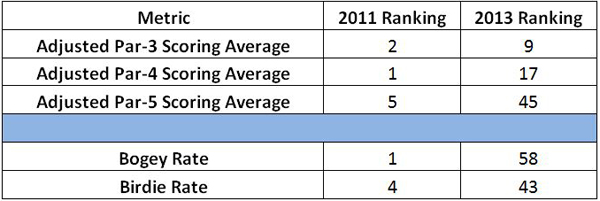
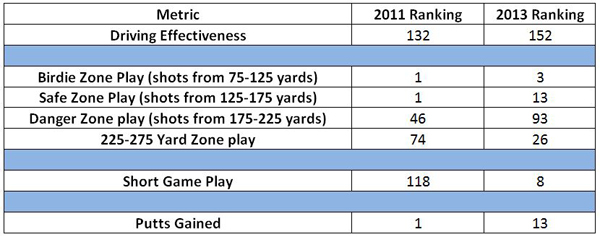



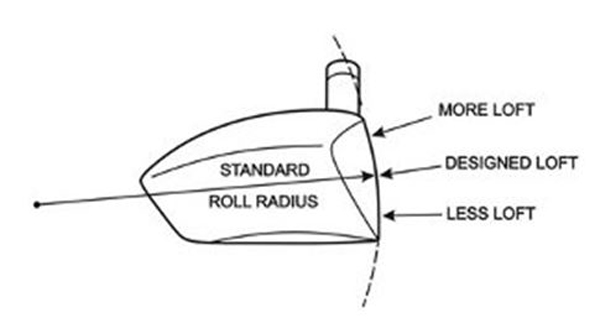



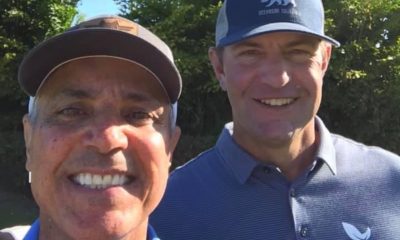









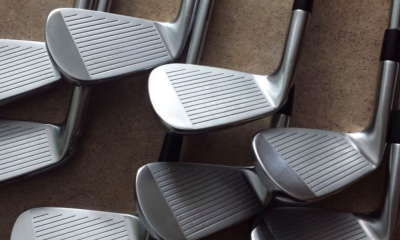














MartyMouse
Oct 12, 2013 at 8:02 am
Enough about dynamic Loft!! Luke still has all the tools to get right back on top. Very interesting and well written! Thank you Richie!
timmy
Oct 11, 2013 at 5:57 pm
whats the significance of distance to edge data?
isn’t it possible, if not probable, that these pros intended to land the ball on certain spots of the fairway?
middle of the fairway is not always the best spot for second shot
Richie Hunt
Oct 14, 2013 at 3:08 pm
Distance to the Edge of the fairway is based on shots that *miss* the fairway. The significance is it helps measure how large a player’s misses are.
Andrew Cooper
Oct 4, 2013 at 7:09 pm
No disrespect, he’s a very decent player, but how he got to world no.1 beats me..
rdred
Oct 10, 2013 at 7:07 am
What part of it aren’t you understanding? This article has the stats right there, infront of your eyes…Did you read the article before typing your embarrassing comment?
Best from the birdie zone.
Best from the safe zone.
Most Putts Gained.
Best scoring average on par 4s
What part of this are you struggling to understand?
Andrew Cooper
Oct 13, 2013 at 8:33 am
No argument Donald is a very good player-but he’s not a great player. He has strengths, but he also has big weaknesses (162nd in ball striking in 2013).
The key stats are 251 PGA Tour starts, 5 wins, 0 Majors-a very nice career but not World no.1 material…
Roger
Oct 4, 2013 at 2:10 pm
Richie,
Really appreciate the analysis of the info!
The huge drop in 150/175 and 200/225 accuracy is easy to see.
Looks like the 2011 Irons are worth going back too……..
I got into a negative impact around 2 degrees around xmas
after being a +- Zero degrees hitter…took a while to fix!
Keep up the Very Interesting Articles please!
You know you can’t win over all the viewers in todays Instant Expert
World……………………………………………………………………………………
naflack
Oct 5, 2013 at 3:53 am
passive aggressive and snarky, yes. subtle, no.
FS
Oct 3, 2013 at 11:23 am
Very interesting!
Did he also change balls during this same period? Has the change in the ball affected the numbers that much?
The driver change obviously has affected it, for sure, but I wonder about the ball itself too. I wish there was some kind of machine that could tell us bit more about compression data of balls at impact besides just the Trackman smash factor data.
How about the shaft? Did he change shaft when he changed the head?
We all know that he also struggled with the change from the MP-62 to the 64.
Obviously if his proximity to the hole suffers he has to work harder on the greens so the putting suffers and it shows.
Nothing wrong with having a new set of eyes take a look at you. I hope he makes a good comeback next year.
Richie Hunt
Oct 3, 2013 at 2:07 pm
I don’t know if he changed golf balls or shaft, etc. That’s why I stated that perhaps the equipment causes his unorthodox radar numbers with the driver.
Putts Gained is based on putts made percentage, BUT with relation to the field. And it’s where the golfer putts from. So not hitting your irons as well is technically separate from Putts Gained because it’s basing it on your ability to make putts from certain distances. If you’re leaving yourself with 20 foot putts instead of 10 foot putts, obviously…you’ll make less putts. But, that doesn’t matter in putts gained because it’s testing how well you can make those 20 foot putts (in this example) versus how well the field does from 20 feet.
naflack
Oct 3, 2013 at 8:43 am
If you already know that…why are stating the hitting down creates backspin when you clearly know that it doesn’t?
naflack
Oct 3, 2013 at 8:55 am
Sorry but that makes no sense…
I watched the maestro explain the entire thing.
I’ll trust his explanation over yours, it’s makes more sense.
Besides the fact that trackman data tells us that hitting down does not create spin by itself. Otherwise guys who hit down with their drivers would need less loft not more.
I don’t understand with your knowledge how you draw such a conclusion that the player exhibited alone disputes?
Eric
Oct 3, 2013 at 10:10 am
https://www.google.com/url?sa=t&rct=j&q=&esrc=s&source=web&cd=2&cad=rja&ved=0CDUQFjAB&url=http%3A%2F%2Ftrackmangolf.com%2Fmedia%2F5bf8af87-1695-42f4-9bab-7235dff40c5c%2F-366222283%2FPDF%2F3.%2520Newsletter%2Fnewsletter7.pdf&ei=FXpNUqWRBaLbyQGUr4GICw&usg=AFQjCNH1hgUOtwI3ycrzx71h-aRqhw-kXA&sig2=55oagnKooa6ICoqpsr7bdQ&bvm=bv.53537100,d.aWc
If by “hitting down” you mean increasing downward angle of attach while also tilting the club face down by the same amount, you’re right, no change in spin rate. But if your angle of attack is increased downward while the clubfaces remains the same, result is higher spin rate.
So, if Donald knows he should have a launch angle with a driver of about 11-12 degrees, and is changing the driver static loft to achieve it while using a -2.5 deg AoA, the spin will increase. He should do the opposite to increase distance…raise AoA, but use loft that continues to get about 11 degrees of launch angle.
naflack
Oct 3, 2013 at 11:13 pm
i wonder how many golfers understand the subtext involved, im guessing not many…
Richie Hunt
Oct 3, 2013 at 10:34 am
I can guarantee you that Trackman Maestro would agree with me that dynamic loft by itself (as well as attack angle) will not increase the spin rate. It’s the increase in the difference between AoA and dynamic loft, otherwise known as Spin Loft, that increases or decreases spin rate.
naflack
Oct 3, 2013 at 11:08 pm
im sure he would agree with the above premise…
i dont however believe he would agree with the statement in the article that downward angle of attack increases spin rate.
ive watched his videos, he states over and over again that the statement “hitting down increases spin” in and of itself is a myth. the distinction is important because the average golfer doesnt understand the difference between hitting down and spin loft. they see hitting down increases spin when unless they know how to do it properly it oly hurts their game.
perhaps im the idiot and all the readers know the distinction, either way i felt the need to comment and appreciate your responses none the less.
Richie Hunt
Oct 4, 2013 at 8:58 am
I think we typically see golfers generating more spin when they hit down because their spin loft is *likely* to increase. They may bring their dynamic loft down with it, but generally not enough to keep the spin loft consistent (at least IMO).
The real point of that portion of the article was to explore Donald’s struggles with the driver over his career. I don’t know his average dynamic loft, but I did know his average attack angle. What I found interesting was his launch angle would increase and he had very unorthodox numbers when we look at his club head speed, spin rate, max height, distance, etc.
It could be an equipment thing, but it could be where he is hitting the ball. And I’ve worked with a couple of clients that changed how high they tee the ball up and that has affected their radar metrics and subsequently their driving off the tee.
I usually try to tie these articles in with what the average amateur could possibly learn. There’s a popular myth that hitting above the sweet spot on the modern driver is a ‘hot spot’ on the driver. It’s actually not and I was trying to bring that to the attention of the reader and show a possible case of where this may be detrimental to a player like Luke Donald.
naflack
Oct 3, 2013 at 4:03 am
downward angle of attack DOES NOT produce a higher spin rate, more dynamic loft produces a higher spin rate.
the fact that he is as high as 19 in spin rate indicates that hitting down with the driver isnt increasing his spin rate.
dont believe me…google “track man maestro” then watch him on youtube.
Richie Hunt
Oct 3, 2013 at 7:59 am
Sorry, but that’s incorrect. Dynamic loft by itself does NOT produce a higher spin rate. It’s about Spin Loft which is the difference between the Dynamic Loft and the Attack Angle. So all things being equal, if the attack angle gets steeper the spin loft increases and thus the spin rate increases. Conversely, all things being equal…if the dynamic loft increases the spin loft increases which means the spin will increase.
td
Oct 2, 2013 at 8:59 pm
“The best way to avoid bogeys is to not put yourself in position to make them.”
Haha…I swear this guy is Tim Mccarver’s prodigy.
Lawrie Montague
Oct 2, 2013 at 8:39 pm
Rich thank you for sharing your analysis of Luke Donald’s current challenges with his game.
With the wealth of statistical data available to us it is fortunate that we have people like yourself who can drill down into the data and present it in a way that makes sense.
I wonder whether Luke Donald will be able to change his game enough to improve the numbers you suggest if he has to change some aspect of his golf swing.
I imagine that someone as knowledgeable and experienced as Chuck Cook will guide him carefully, but as someone who works with tour players and elite amateurs helping them to improve their numbers in key areas of their game it’s indeed a slippery slope.
Get it wrong and even great golfers are lost to the golf swing change wilderness, but get it right and Luke Donald might be able to bag himself a major or two.
Only time will tell. Thanks again for an insightful article.